Carbon-Silica Composite as Adsorbent for Removal of Hazardous C.I. Basic Yellow 2 and C.I. Basic Blue 3 Dyes
Abstract
1. Introduction
2. Materials and Methods
2.1. Composite and Dyes
2.2. Adsorption Studies
2.2.1. Isotherm Studies
2.2.2. Thermodynamic Studies
2.3. Electrokinetic Studies
3. Results
3.1. Isotherm Studies
3.2. Thermodynamic Parameters
3.3. Phase Contact Time and Surfactant Impact on Basic Dye Adsorption
3.4. Electrokinetic Results
4. Conclusions
Author Contributions
Funding
Institutional Review Board Statement
Informed Consent Statement
Data Availability Statement
Conflicts of Interest
References
- Upadhyay, K.K.; Pandey, A.C.; Manzoor, J. Impact of Dyes on the Chemistry of Water and its Implications: A Review. Bio Bull. 2017, 3, 1–7. [Google Scholar]
- Berradi, M.; Hsissou, R.; Khudhair, M.; Assouag, M.; Cherkaoui, O.; El Bachiri, E.; El Harfi, A. Textile finishing dyes and their impact on aquatic environs. Helyion 2019, 5, e02711. [Google Scholar] [CrossRef]
- Hynes, N.R.J.; Kumar, J.S.; Kamyab, H.; Sujana, J.A.J.; Al-Khashman, O.A.; Kuslu, Y.; Ene, A.; Kumar, B.S. Modern enabling techniques and adsorbents based dye removal with sustainability concerns in textile industrial sector—A comprehensive review. J. Clean. Prod. 2020, 272, 122636. [Google Scholar] [CrossRef]
- Tofighy, M.A.; Mohammadi, T. Adsorption of divalent heavy metal ions from water using carbon nanotube sheets. J. Hazard. Mater. 2011, 185, 140–147. [Google Scholar] [CrossRef] [PubMed]
- Thamer, B.M.; Aldalbahi, A.; Moydeen, M.; Al-Enizi, A.M.; El-Hamshary, H.; Singh, M.; Bansal, V.; El-Newehy, M.H. Alkali-activated electrospun carbon nanofibers as an efficient bifunctional adsorbent for cationic and anionic dyes. Colloids Surf. A 2019, 582, 123835. [Google Scholar] [CrossRef]
- Zhang, Y.; Ou, H.; Liu, H.; Ke, Y.; Zhang, W.; Liao, G.; Wang, D. Polyimide-based carbon nanofibers: A versatile adsorbent for highly efficient removals of chlorophenols, dyes and antibiotics. Colloids Surf. A 2018, 537, 92–101. [Google Scholar] [CrossRef]
- Konicki, W.; Aleksandrzak, M.; Moszyński, D.; Mijowska, E. Adsorption of anionic azo-dyes from aqueous solutions onto graphene oxide: Equilibrium, kinetic and thermodynamic studies. J. Colloid Interface Sci. 2017, 496, 188–200. [Google Scholar] [CrossRef]
- Boruah, P.K.; Sharma, B.; Hussain, N.; Das, M.R. Magnetically recoverable Fe3O4/graphene nanocomposite towards efficient removal of triazine pesticides from aqueous solution: Investigation of the adsorption phenomenon and specific ion effect. Chemosphere 2017, 168, 1058–1067. [Google Scholar] [CrossRef]
- Yu, F.; Ma, J.; Bi, D. Enhanced adsorptive removal of selected pharmaceutical antibiotics from aqueous solution by activated graphene. Environ. Sci. Pollut. Res. 2015, 22, 4715–4724. [Google Scholar] [CrossRef]
- Wiśniewska, M.; Nowicki, P. Peat-based activated carbons as adsorbents for simultaneous separation of organic molecules from mixed solution of poly(acrylic acid) polymer and sodium dodecyl sulfate surfactant. Colloids Surf. A 2020, 585, 124179. [Google Scholar] [CrossRef]
- Szewczuk-Karpisz, K.; Wiśniewska, M.; Nowicki, P.; Oleszczuk, P. Influence of protein internal stability on its removal mechanism from aqueous solutions using eco-friendly horsetail herb-based engineered biochar. Chem. Eng. J. 2020, 388, 124156. [Google Scholar] [CrossRef]
- Yang, X.; Wan, Y.; Zheng, Y.; He, F.; Yu, Z.; Huang, J.; Gao, B. Surface functional groups of carbon-based adsorbents and their roles in the removal of heavy metals from aqueous solutions: A critical review. Chem. Eng. J. 2019, 366, 608–621. [Google Scholar] [CrossRef]
- Szewczuk-Karpisz, K.; Wiśniewska, M.; Medykowska, M.; Galaburda, M.V.; Bogatyrov, V.M.; Oranska, O.I.; Błachnio, M.; Oleszczuk, P. Simultaneous adsorption of Cu(II) ions and poly(acrylic acid) on the hybrid carbon-mineral nanocomposites with metallic elements. J. Hazard. Mater. 2021, 412, 125138. [Google Scholar] [CrossRef]
- Szewczuk-Karpisz, K.; Wiśniewska, M.; Medykowska, M.; Bogatyrov, V.; Sokołowska, Z. Adsorption layer structure on the surface of carbon-silica composite in the presence of proteins of different internal stability and Cu(II) ions—The effect on solid aggregation. J. Mol. Liq. 2020, 309, 113072. [Google Scholar] [CrossRef]
- Szewczuk-Karpisz, K.; Bogatyrov, V.M.; Galaburda, M.; Sokołowska, Z. Study on Adsorption and Aggregation in the Mixed System of Polyacrylamide, Cu(II) Ions and Innovative Carbon–Silica Composite. Polymers 2020, 12, 961. [Google Scholar] [CrossRef]
- Lellis, B.; Fávaro-Polonio, C.Z.; Pamphile, J.A.; Polonio, J.C. Effects of textile dyes on health and the environment and bioremediation potential of living organisms. Biotechnol. Res. Innov. 2019, 3, 275. [Google Scholar] [CrossRef]
- Muhammad, A.; Shah, A.H.A.; Bilal, S.; Rahman, G. Basic blue dye adsorption from water using polyaniline/magnetite (Fe3O4) composites: Kinetic and thermodynamic aspects. Materials 2019, 12, 1764. [Google Scholar] [CrossRef]
- Foo, K.Y.; Hameed, B.H. Insights into the modeling of adsorption isotherm systems. Chem. Eng. J. 2010, 156, 2–10. [Google Scholar] [CrossRef]
- Marković, D.D.; Lekić, B.M.; Rajaković-Ognjanović, V.N.; Onjia, A.E.; Rajaković, L.V. A new approach in regression analysis for modeling adsorption isotherms. Sci. World J. 2014, 2014, 930879. [Google Scholar] [CrossRef]
- Sivarajasekar, N.; Baskar, R. Adsorption of Basic Magenta II onto H2SO4 activated immature Gossypium hirsutum seeds: Kinetics, isotherms, mass transfer, thermodynamics and process design. Arab. J. Chem. 2019, 1322–1337. [Google Scholar] [CrossRef]
- Liu, Y. Is the free energy change of adsorption correctly calculated? J. Chem. Eng. Data 2009, 54, 1981–1982. [Google Scholar] [CrossRef]
- Janusz, W. Electrical double layer at metal oxide-electrolyte interface. In Interfacial Forces and Fields Theory and Applications; Dekker, M., Ed.; CRC Pres: New York, NY, USA, 1999. [Google Scholar]
- Oshima, H. A simple expansion for Henry’s function for the retardation effect in electrophoresis of spherical colloidal particles. J. Colloid Interface Sci. 1994, 168, 269–271. [Google Scholar] [CrossRef]
- Siew-Teng, O.; Suat-Yen, T.; Eng-Cheong, K.; Siew-Ling, L.; Sie-Tiong, H. Equilibrium studies for Basic blue 3 adsorption onto durian peel (Durio zibethinus Murray). Desal. Water Treat. 2012, 45, 161. [Google Scholar] [CrossRef]
- Crini, G.; Gimbert, F.; Robert, C.; Martel, B.; Adam, O.; Morin-Crini, N.; Badot, P.-M. The removal of Basic Blue 3 from aqueous solutions by chitosan-based adsorbent: Batch studies. J. Hazard. Mater. 2008, 153, 96. [Google Scholar] [CrossRef]
- Taşar, Ş.; Kaya, F.; Özer, A. Adsorption of C.I. Basic Blue 3 dye molecules from aqueous media by sulfuric acid-activated montmorillonite mineral. J. Turk. Chem. Soc. B 2017, 1, 1. [Google Scholar]
- Öztürk, A.; Malkoc, E. Adsorptive potential of cationic Basic Yellow 2 (BY2) dye onto natural untreated clay (NUC) from aqueous phase: Mass transfer analysis, kinetic and equilibrium profile. Appl. Surf. Sci. 2014, 299, 105. [Google Scholar] [CrossRef]
- Öztürk, A.; Malkoc, E. Cationic Basic Yellow 2 (BY2) adsorption onto manure ash: Surface properties and adsorption mechanism. Desal. Water Treat. 2014, 54, 209. [Google Scholar] [CrossRef]
- Aber, S.; Esfahlan, F.H. Removal of C.I. Basic Yellow 2 from aqueous solution by adsorption onto granular activated carbon using an on-line spectrophotometric analysis system: Kinetic and equilibrium study. Glob. NEST J. 2011, 13, 246. [Google Scholar]
- Mall, I.D.; Srivastava, V.C.; Agarwal, N.K. Adsorptive removal of Auramine-O: Kinetic and equilibrium study. J. Hazard. Mater. 2007, 143, 386. [Google Scholar] [CrossRef]
- Goscianska, J.; Marciniak, M.; Pietrzak, R. The effect of surface modification of mesoporous carbons on Auramine-O dye removal from water. Adsorption 2015, 22, 531. [Google Scholar] [CrossRef]
- Nwafor, N.P.; Moutloali, R.M.; Sikhwivhilu, K.; Familoni, O.B.; Adams, L.A. Antifouling polyethersulfone-petrol soot nanoparticles composite ultrafiltration membrane for dye removal in wastewater. Membranes 2021, 11, 361. [Google Scholar] [CrossRef]
- Ahmed, I.A.; Ragab, A.H.; Habila, M.A.; Alomar, T.S.; Aljuhani, E.H. Equilibrium and kinetic study of anionic and cationic pollutants remediation by limestone—Chitosan—alginate nanocomposite from aqueous solution. Molecules 2021, 26, 2586. [Google Scholar] [CrossRef]
- Spoială, A.; Ilie, C.-I.; Ficai, D.; Ficai, A.; Andronescu, E. Chitosan-based nanocomposite polymeric membranes for water purification-a review. Materials 2021, 14, 2091. [Google Scholar] [CrossRef]
- Kadhim, R.J.; Al-Ani, F.H.; Al-shaeli, M.; Alsalhy, Q.F.; Figoli, A. Removal of dyes using graphene oxide (GO) mixed matrix membranes. Membranes 2020, 10, 366. [Google Scholar] [CrossRef]
- Marotta, A.; Luzzi, E.; Salzano de Luna, M.; Aprea, P.; Ambrogi, V.; Filippone, G. Chitosan/zeolite composite aerogels for a fast and effective removal of both anionic and cationic dyes from water. Polymers 2021, 13, 1691. [Google Scholar] [CrossRef]
- Kashefi Alasl, M.; Khosravi, M.; Marandi, R.; Seyedi, K.; Khataei, A.R. Investigation of Basic Yellow 2 removal from contaminated water by electrocoagulation method in the batch reactor. J. Environ. Sci. Technol. 2005, 26, 78–97. [Google Scholar]
- Hmani, E.; Samet, Y.; Abdelhédi, R. Electrochemical degradation of auramine-O dye at boron-doped diamond and lead dioxide electrodes. Diam. Relat. Mater. 2012, 30, 1–8. [Google Scholar] [CrossRef]
- Montazerozohori, M.; Nasr-Esfahani, M.; Moradi-Shammi, Z.; Malekhoseini, A. Photocatalytic decolorization of auramine and its kinetics study in the presence of two different sizes titanium dioxide nanoparticles at various buffer and non-buffer media. J. Industr. Eng. Chem. 2015, 21, 1044–1050. [Google Scholar] [CrossRef]
- Özcan, A.; Şahin, Y.; Koparal, S.; Oturan, M.A. Electro-Fenton removal of the cationic dye Basic Blue 3 by using carbon felt cathode. Environ. Eng. Manag. J. 2009, 19, 267–275. [Google Scholar]
- Khataee, A.; Taseidifar, M.; Sheydaei, M.; Khorram, S.; Woo Joo, S. Sonocatalytic degradation of Basic Blue 3 using plasma-treated magnetite nanostructures. Curr. Nanosci. 2015, 12, 125–134. [Google Scholar] [CrossRef]
- Dhaif-Allah, M.A.H.; Taqui, S.N.; Syed, U.T.; Syed, A.A. Kinetic and isotherm modeling for acid blue 113 dye adsorption onto low-cost nutraceutical industrial fenugreek seed spent. App. Water Sci. 2020, 10, 58. [Google Scholar] [CrossRef]
- El-Azazy, M.; El-Shafie, A.S.; Ashraf, A.; Issa, A.A. Eco-structured biosorptive removal of Basic Fuchsin using pistachio nutshells: A definitive screening design-based approach. Appl. Sci. 2019, 9, 4855. [Google Scholar] [CrossRef]
- Jahan, K.; Balzer, S.; Mosto, P. Toxicity of nonionic surfactants. WIT Trans. Ecol. Environ. 2008, 110, 281. [Google Scholar] [CrossRef]
- Skwarek, E.; Janusz, W. Adsorption of Cd(II) ions at the hydroxyapatite/electrolyte solution interface. Adsorption 2016, 51, 11–21. [Google Scholar] [CrossRef]
- Skwarek, E.; Janusz, W. Study of sorption processes of strontium on the synthetic hydroxyapatite. Adsorption 2016, 22, 697–706. [Google Scholar]
- Kasprzyk-Hordern, B. Chemistry of alumina, reactions in aqueous solution and its application in water treatment. Adv. Colloid Interf. Sci. 2004, 110, 19–48. [Google Scholar] [CrossRef]
- Wiśniewska, M.; Chibowski, S.; Urban, T.; Sternik, D. Investigation of the alumina properties with adsorbed polyvinyl alcohol. J. Therm. Anal. Calorim. 2011, 103, 329–337. [Google Scholar] [CrossRef]
- Wawrzkiewicz, M.; Wiśniewska, M.; Gun’ko, V.M.; Zarko, V.I. Adsorptive removal of acid, reactive and direct dyes from aqueous solutions and wastewater using mixed silica-alumina oxide. Powder Tech. 2015, 278, 306–315. [Google Scholar] [CrossRef]
- Wiśniewska, M.; Nowicki, P.; Urban, T. Influence of surfactants with different ionic character on the structure of poly(acrylic acid) adsorption layer on the activated biocarbons surface—Electrokinetic and stability studies. J. Mol. Liq. 2021, 332, 115872. [Google Scholar] [CrossRef]
- M’Pandou, A.; Siffert, B. Polyethylene glycol adsorption at the TiO2-H2O interface: Distortion of ionic structure and shear plane position. Colloids Surf. A 1987, 4, 159–172. [Google Scholar] [CrossRef]
- Hunter, R.J. Zeta Potential in Colloid Science; Academic Press: New York, NY, USA, 1981. [Google Scholar]

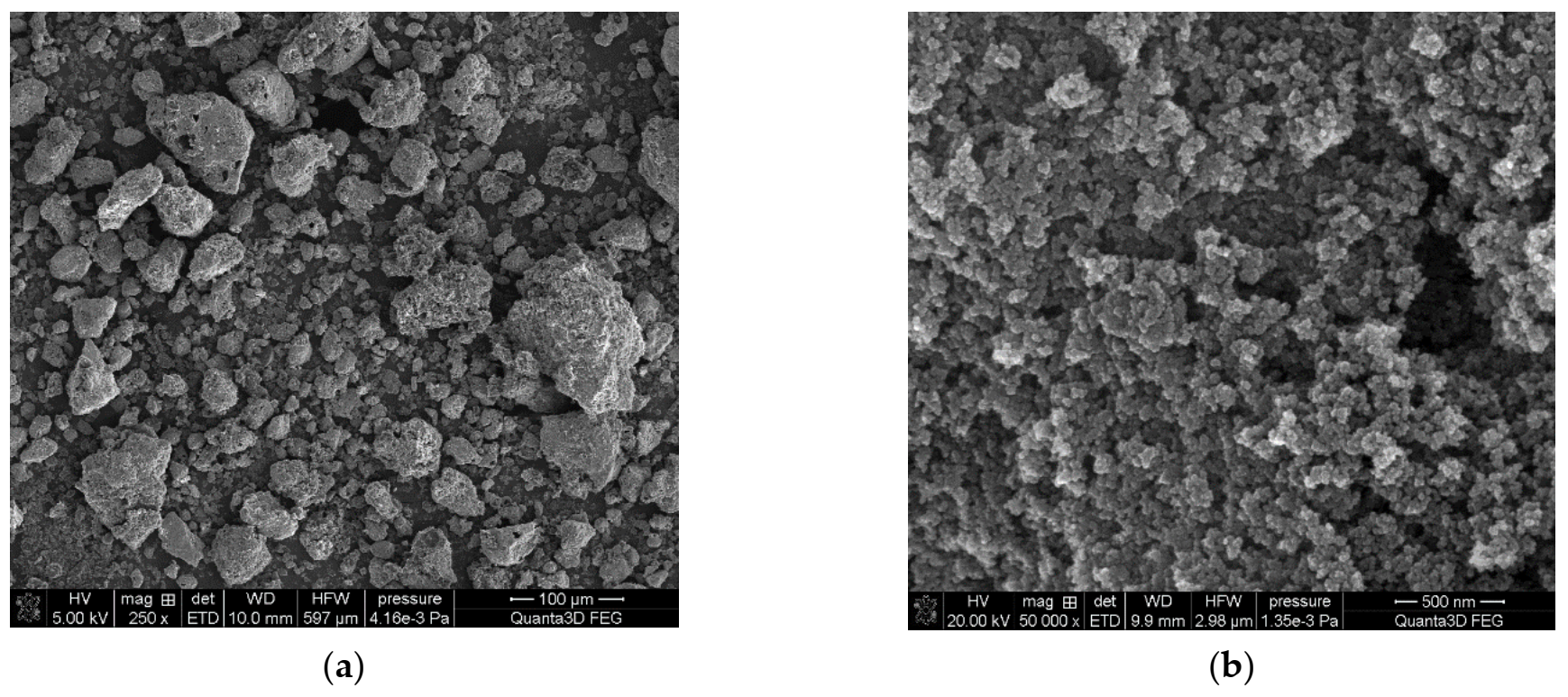
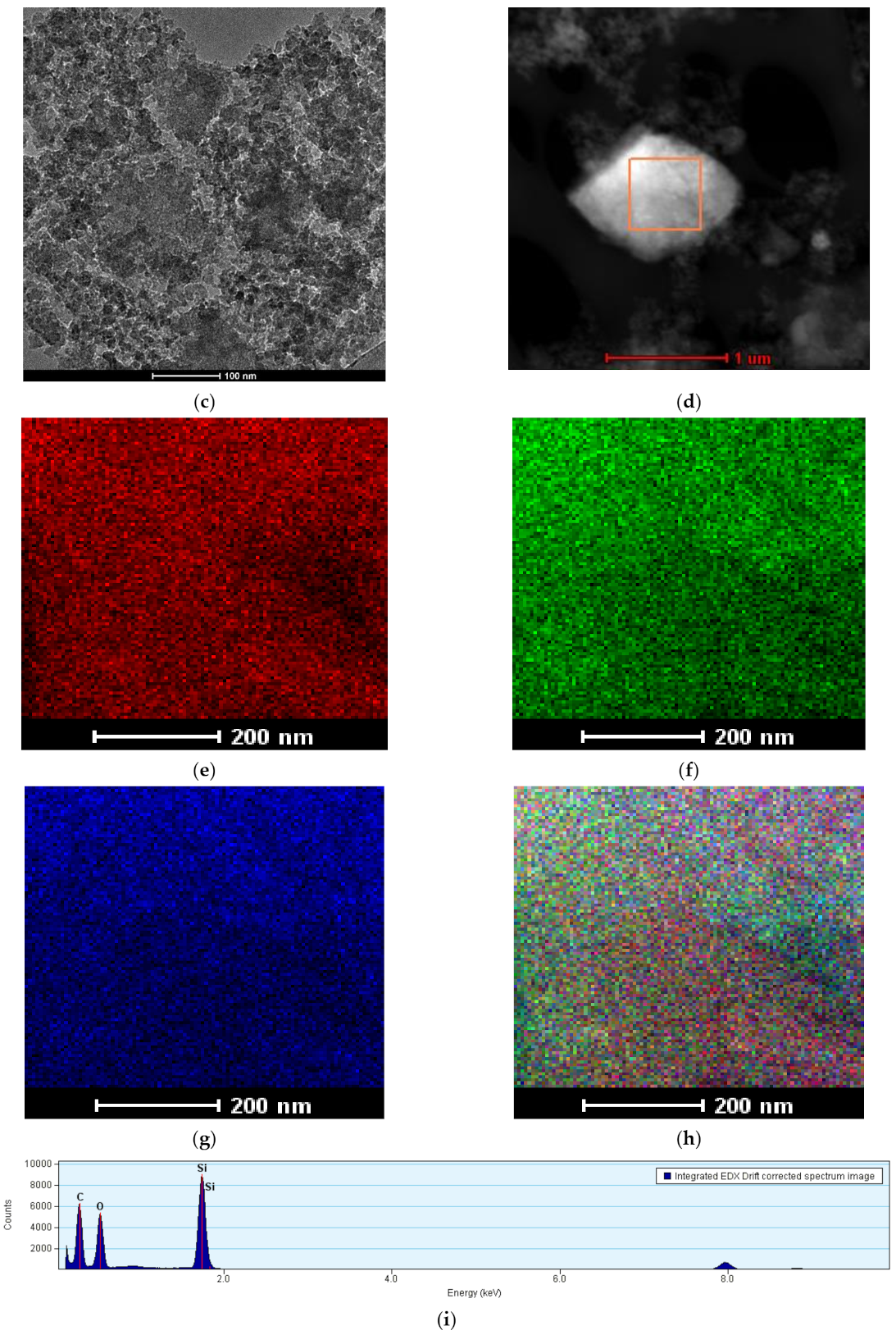
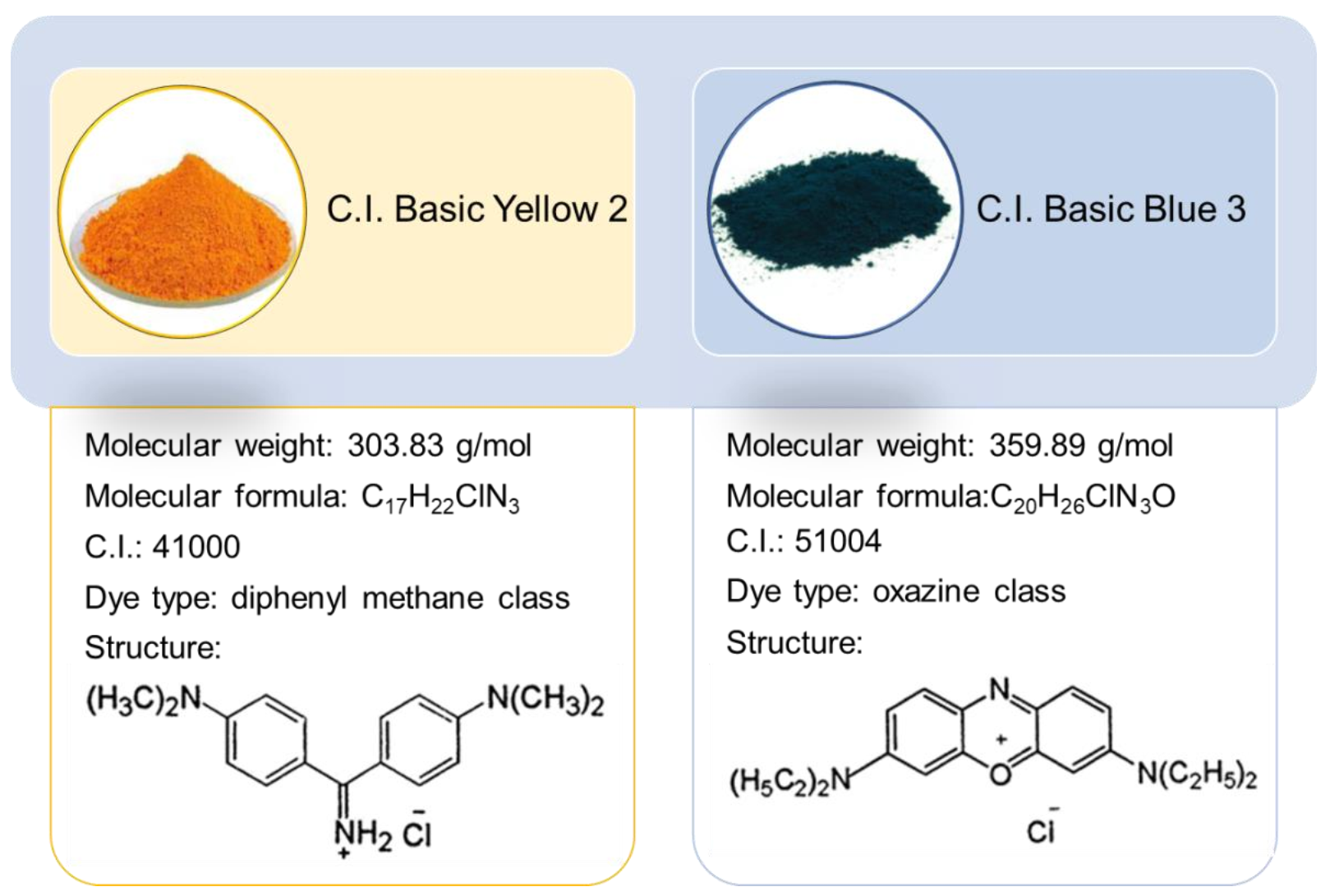
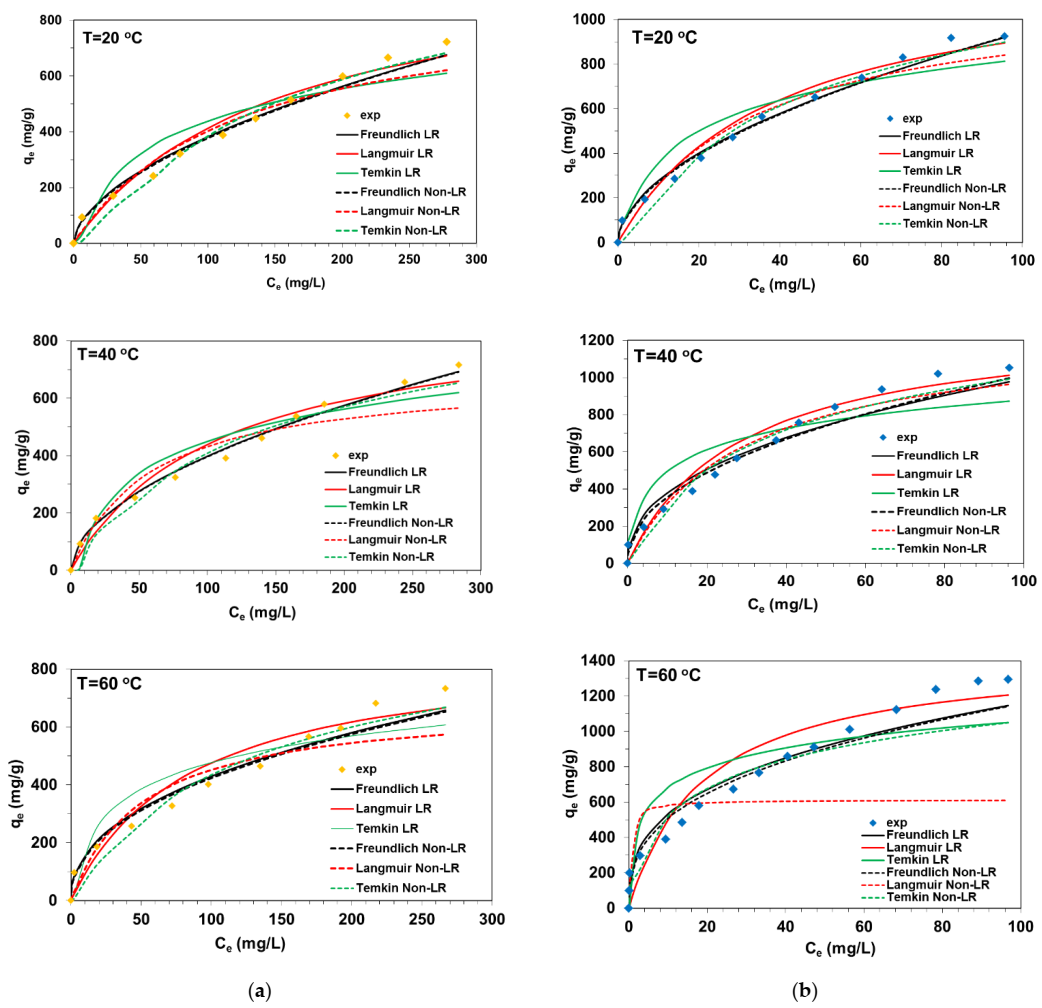
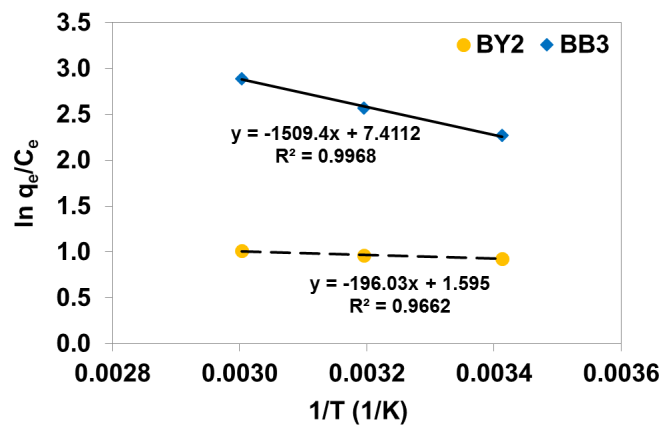
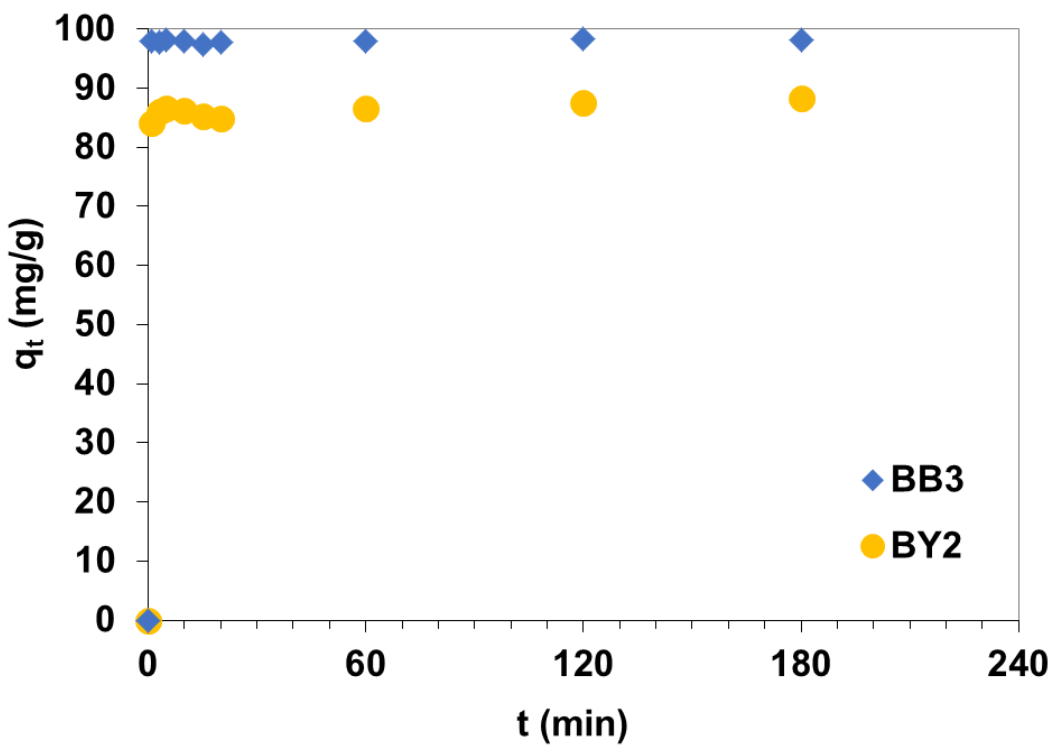
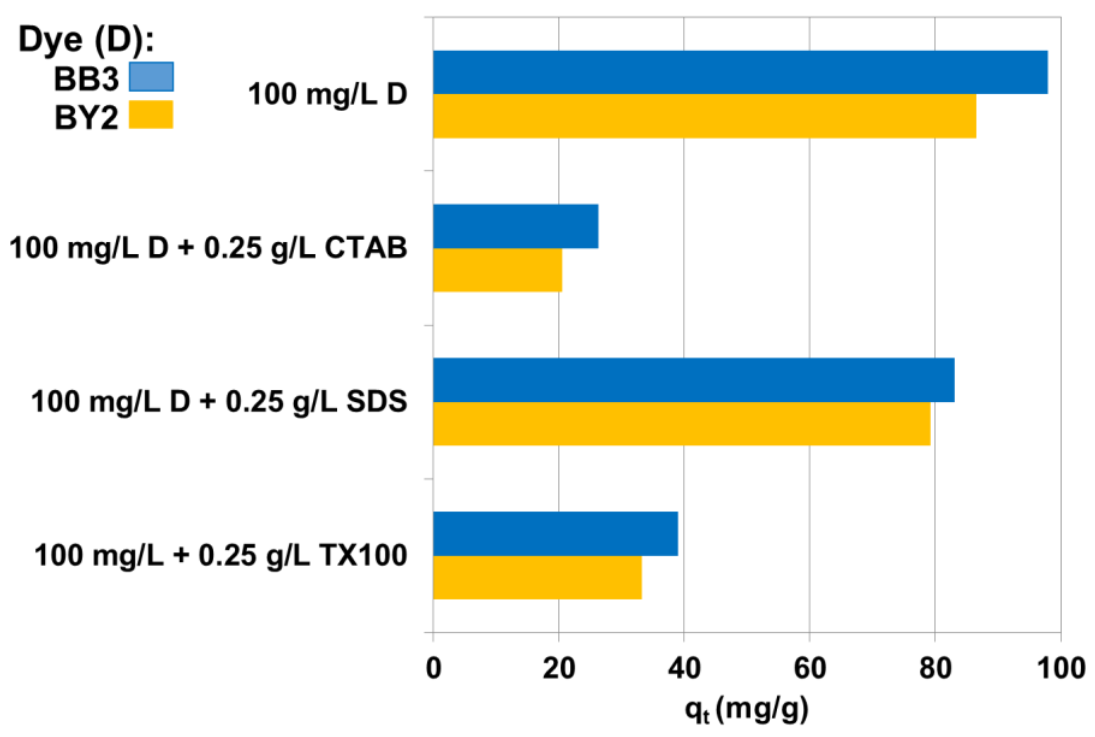
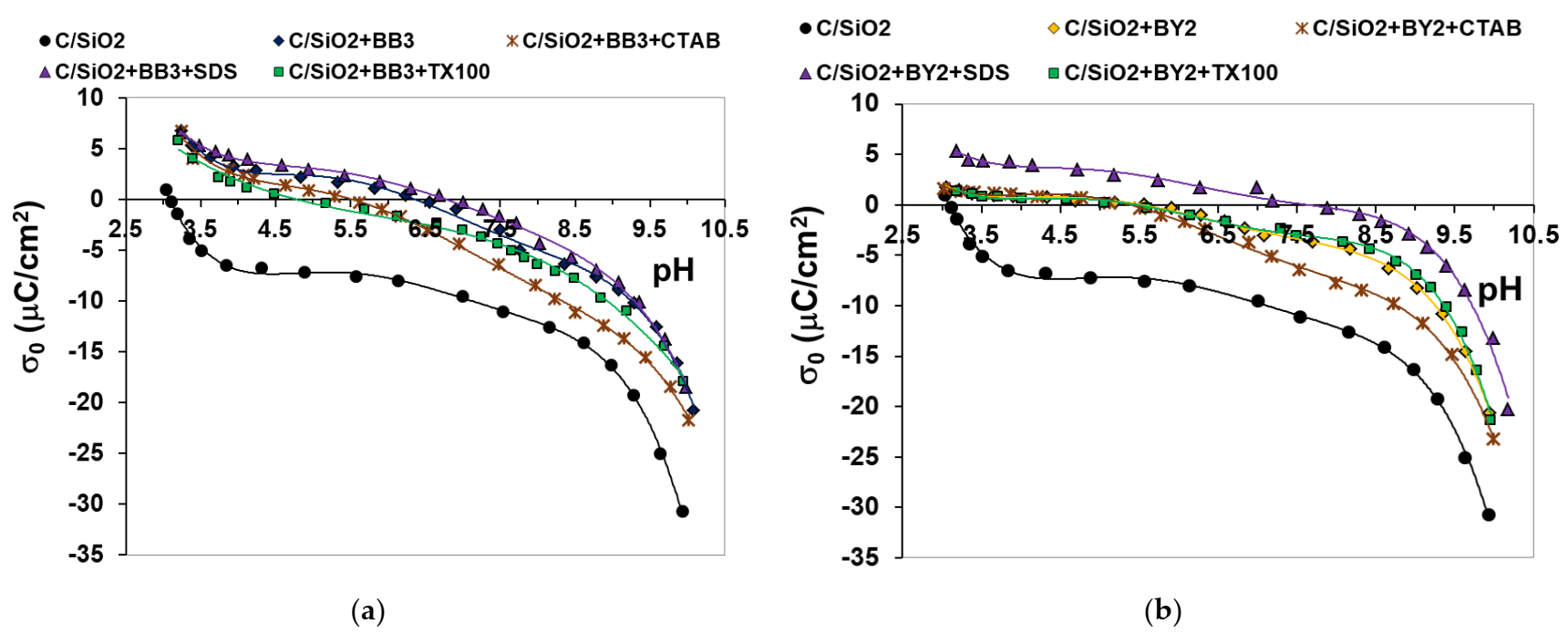
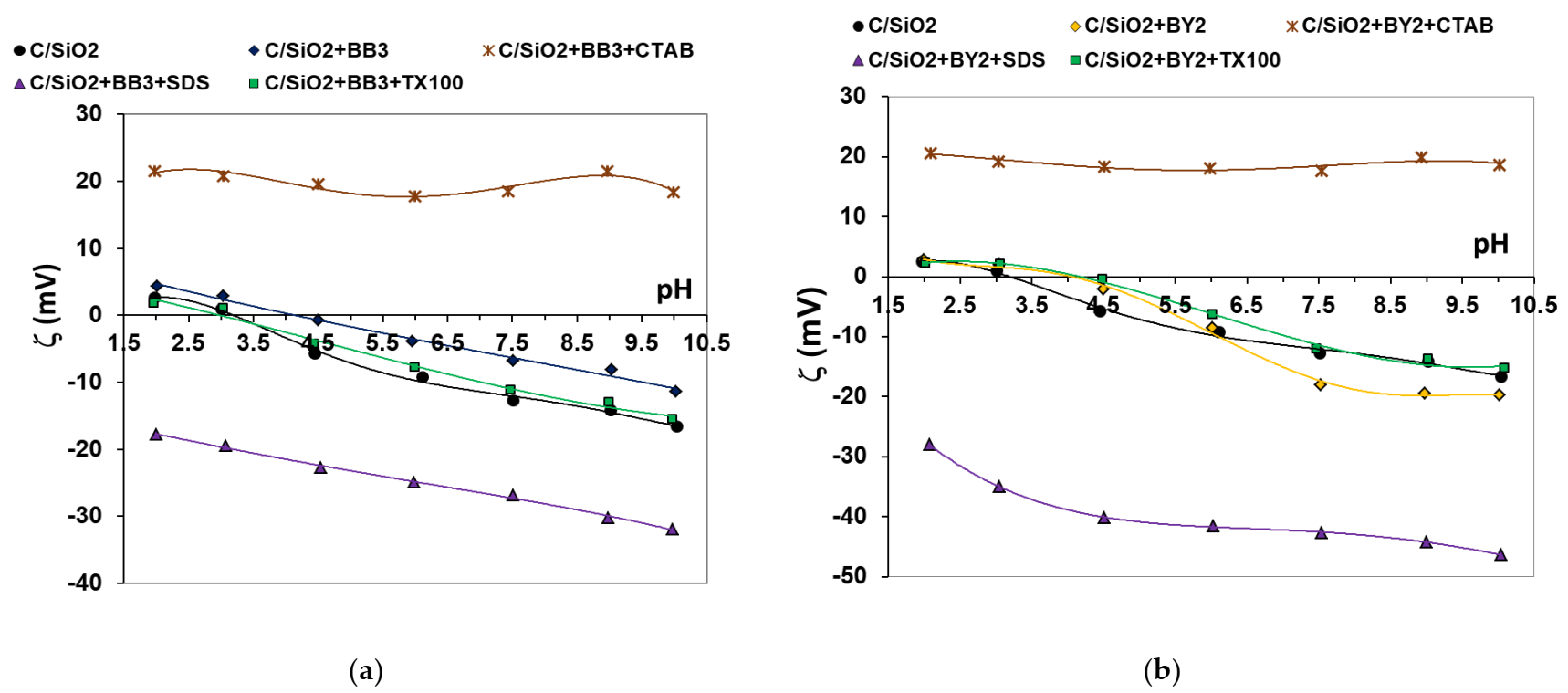
| Isotherm | Equation No. | Non-Linear Forms | Linear Forms |
|---|---|---|---|
| Langmuir | (3)–(4) | ||
| Freundlich | (5)–(6) | ||
| Temkin | (7)–(8) |
| Model | Parameters | BY2 | BB3 | ||||
|---|---|---|---|---|---|---|---|
| Temperature (°C) | |||||||
| 20 | 40 | 60 | 20 | 40 | 60 | ||
| Langmuir | Q0 (mg/g) kL (L/mg) R2 | 1038.8 0.007 0.836 | 905.7 0.010 0.904 | 878.5 0.012 0.876 | 1252.3 0.026 0.904 | 1308.9 0.035 0.901 | 1443.2 0.053 0.914 |
| Freundlich | (mg1−1/n L1/n/g) 1/n R2 | 29.32 0.558 0.977 | 34.50 0.531 0.991 | 58.11 0.434 0.970 | 81.56 0.531 0.984 | 144.25 0.419 0.948 | 243.99 0.338 0.946 |
| Temkin | bT (J g/mol mg) A (L/mg) R2 | 14.77 0.137 0.838 | 15.23 0.160 0.894 | 18.64 0.362 0.812 | 12.38 0.608 0.847 | 14.86 1.952 0.760 | 15.22 6.565 0.773 |
| Model | Parameters | BY2 | BB3 | ||||
|---|---|---|---|---|---|---|---|
| Temperature (°C) | |||||||
| 20 | 40 | 60 | 20 | 40 | 60 | ||
| Langmuir | Q0 (mg/g) kL (L/mg) MPSD R2 | 891.8 0.008 0.405 0.946 0.930 | 680.8 0.017 0.255 0.897 0.867 | 686.3 0.019 0.699 0.874 0.838 | 1134.1 0.030 0.504 0.964 0.956 | 1251.7 0.035 0.949 0.962 0.954 | 613.5 1.75 2.350 0.471 0.383 |
| Freundlich | (mg1−1/n L1/n/g) 1/n MPSD R2 | 27.37 0.570 0.0879 0.991 0.988 | 34.09 0.533 0.032 0.993 0.991 | 55.41 0.442 0.109 0.978 0.971 | 77.70 0.543 0.083 0.994 0.992 | 124.55 0.456 0.287 0.983 0.979 | 223.25 0.357 0.365 0.970 0.965 |
| Temkin | bT (J g/mol mg) A (L/mg) MPSD R2 | 8.51 0.038 0.936 0.977 0.971 | 10.59 0.058 0.988 0.961 0.950 | 10.42 0.062 1.004 0.958 0.946 | 7.57 0.163 0.999 0.982 0.977 | 7.95 0.249 1.059 0.970 0.964 | 10.52 0.891 1.352 0.915 0.901 |
| Kind of Adsorbent | qe (mg/g) | Ref. |
|---|---|---|
| BB3 | ||
| Durian peel | 49.5 | [24] |
| Chitosan-based adsorbent | 166.5 | [25] |
| Sulfuric acid-activated montmorillonite | 277 | [26] |
| Fe3O4 | 7.474 | - |
| PANI (polyaniline) | 47.977 | [17] |
| PANI/Fe3O4 composite | 78.13 | - |
| C/SiO2 composite | 925–1296 | This study |
| BY2 | ||
| Natural untreated clay (Pasinler clay, originating from the eastern of Turkey) | 833.3 | [27] |
| Manure ash | 1428.6 | [28] |
| Granular activated carbon | 598.8 | [29] |
| Bagasse fly ash Mesoporous carbon oxidized at 30–60 °C C/SiO2 composite | 31.17 172–355.2 716–733 | [30] [31] This study |
| T (°C) | Kc (L/g) | ΔH𝑜 (kJ/mol) | ΔS𝑜 (kJ/mol) | ΔG𝑜 (kJ/mol) |
|---|---|---|---|---|
| BB3 | ||||
| 20 | 9.7 | 12.6 | 61.6 | −22.4 |
| 40 | 13.0 | −24.7 | ||
| 60 | 17.9 | −27.1 | ||
| BY2 | ||||
| 20 | 2.6 | 1.6 | 13.3 | −19.2 |
| 40 | 2.5 | −20.4 | ||
| 60 | 2.7 | −21.9 | ||
Publisher’s Note: MDPI stays neutral with regard to jurisdictional claims in published maps and institutional affiliations. |
© 2021 by the authors. Licensee MDPI, Basel, Switzerland. This article is an open access article distributed under the terms and conditions of the Creative Commons Attribution (CC BY) license (https://creativecommons.org/licenses/by/4.0/).
Share and Cite
Wiśniewska, M.; Wawrzkiewicz, M.; Onyszko, M.; Medykowska, M.; Nosal-Wiercińska, A.; Bogatyrov, V. Carbon-Silica Composite as Adsorbent for Removal of Hazardous C.I. Basic Yellow 2 and C.I. Basic Blue 3 Dyes. Materials 2021, 14, 3245. https://doi.org/10.3390/ma14123245
Wiśniewska M, Wawrzkiewicz M, Onyszko M, Medykowska M, Nosal-Wiercińska A, Bogatyrov V. Carbon-Silica Composite as Adsorbent for Removal of Hazardous C.I. Basic Yellow 2 and C.I. Basic Blue 3 Dyes. Materials. 2021; 14(12):3245. https://doi.org/10.3390/ma14123245
Chicago/Turabian StyleWiśniewska, Małgorzata, Monika Wawrzkiewicz, Magda Onyszko, Magdalena Medykowska, Agnieszka Nosal-Wiercińska, and Viktor Bogatyrov. 2021. "Carbon-Silica Composite as Adsorbent for Removal of Hazardous C.I. Basic Yellow 2 and C.I. Basic Blue 3 Dyes" Materials 14, no. 12: 3245. https://doi.org/10.3390/ma14123245
APA StyleWiśniewska, M., Wawrzkiewicz, M., Onyszko, M., Medykowska, M., Nosal-Wiercińska, A., & Bogatyrov, V. (2021). Carbon-Silica Composite as Adsorbent for Removal of Hazardous C.I. Basic Yellow 2 and C.I. Basic Blue 3 Dyes. Materials, 14(12), 3245. https://doi.org/10.3390/ma14123245








